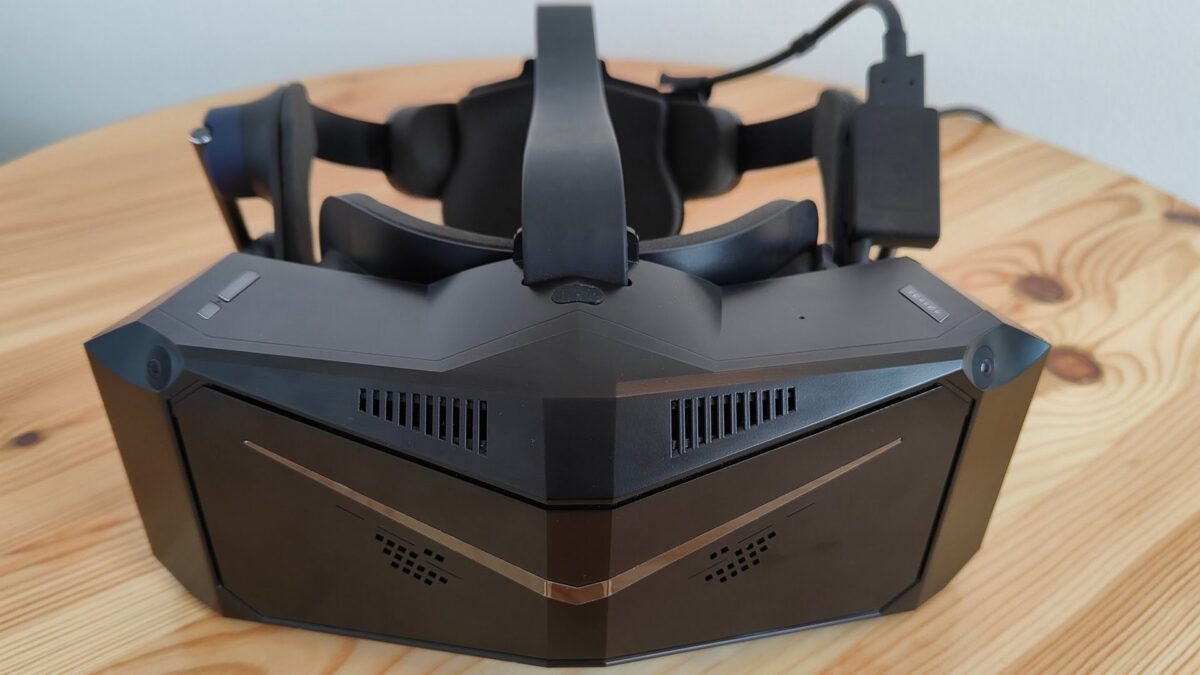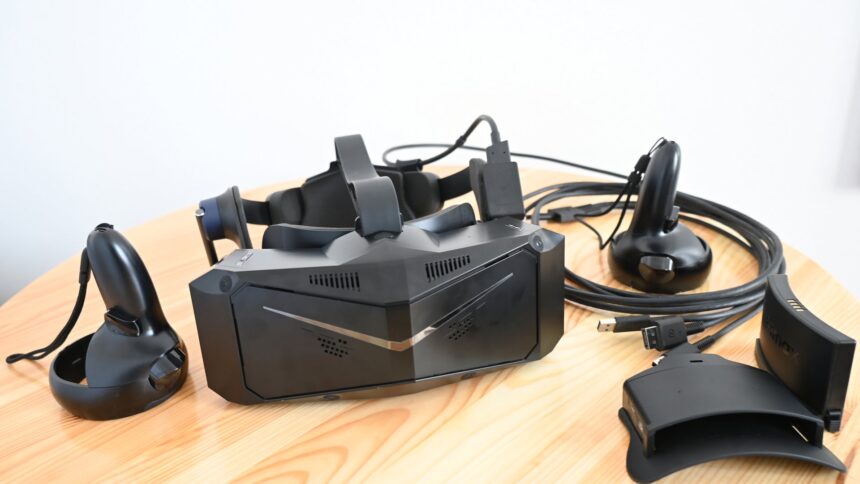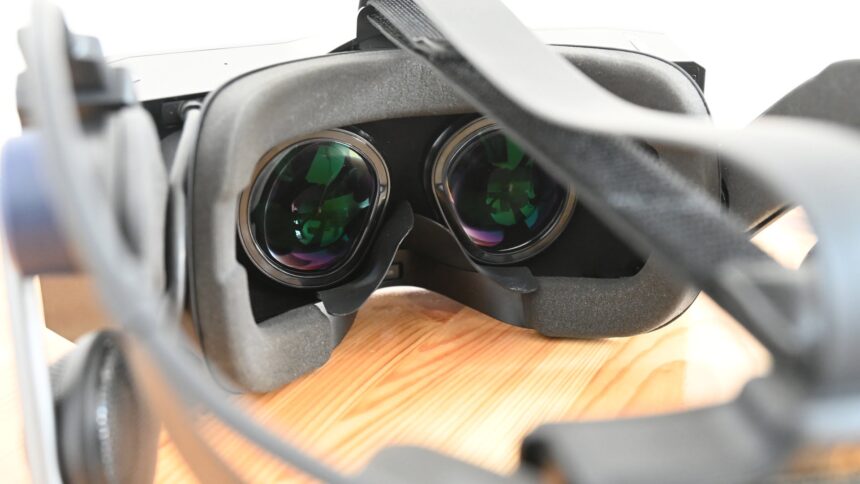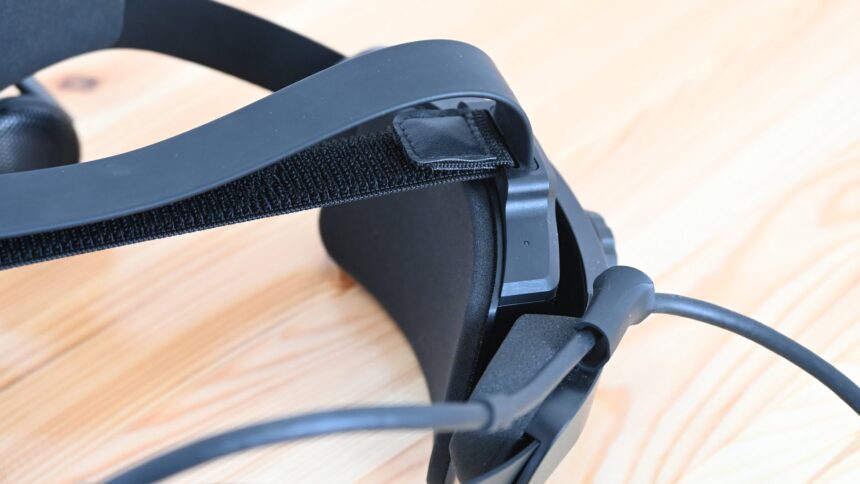Pimax Crystal review: A step in the right direction, but ...

Pimax Crystal aims to set a new standard for PC VR, while also offering the benefits of a standalone VR headset. Will it work?
Pimax's VR headsets, which are partly crowdfunded, have long boasted unique selling points such as a huge field of view of up to 200 degrees or particularly high resolution. However, the quality of the components has often been unsatisfactory, the enormous field of view has caused distortions in the image and various promises have been cancelled or released with long delays.
Pimax has released the Pimax Crystal, and it is officially 'Feature Complete'. In this review, I'll explain what you can and cannot expect.
Content
Pimax Crystal review in a nutshell
For PC VR enthusiasts, the Pimax Crystal is a great thing, especially in terms of the super-sharp, clear image. Simulation gamers in particular will benefit from the lenses' exceptional image quality and high resolution.
However, regular tinkering is part of the deal: you have to constantly repeat set-ups, find workarounds for bugs, wait for updates, plug cables in and out, or even switch to expensive hardware accessories such as the lighthouse tracking faceplate. Mine doesn't work yet, by the way.
The Pimax Crystal's standalone mode, on the other hand, is simply useless. A handful of cheap games in the Pimax store won't get anyone out of their seats because nobody's buying an expensive Crystal to play mobile VR. There are so many better alternatives, such as Quest 3 - which also runs perfectly in PC VR.
A battery solution has been built into the Pimax Crystal for this pointless mode, and this also applies to the PC VR mode: nothing works without the battery, and you need to change or charge the battery after two and a half hours.
This is also a reason why the Crystal is far too heavy and uncomfortable. I think it's only good for simulations when you're sitting down with a headrest. However, if you're looking for an all-round VR headset, you won't be happy with this price/performance ratio.
Pimax Crystal is suitable for you if you …
- want an exceptionally sharp and clear picture,
- mainly play simulations on your PC
- have a powerful PC and
- Don't mind tinkering with hardware and software.
Pimax Crystal is less suitable for you if you …
- want a comfortable, lightweight VR headset,
- want to play good standalone VR,
- expect straightforward and stable functionality, and
- need an affordable VR headset.
Pimax Crystal: Installation and configuration
It remains the same: the configuration battle with cables and at least two different pieces of software on my PC is tedious and requires a lot of time and patience, at least for the initial setup. This is also the case with the Crystal: a DisplayPort cable runs from the VR headset to the graphics card, and two USB cables must also be connected.
As Pimax, for reasons I don't understand, has decided to integrate a standalone mode into the headset, I have to insert a charged battery into the tray at the back of the headband. The battery is charged via an external charging dock, I can't just plug in a USB-C cable. Even though I only use the Crystal for PC VR, when the battery runs out after about two and a half hours, I have to remove the headset and use the hot-swap feature to replace the battery. The latching mechanism for the battery, both on the headset and on the charging dock, is so strong that it hurts my fingers when I try to change the battery.
I then install the Pimax client on my PC and switch on the VR headset. The software now recognizes it almost all the time. If not, plugging and unplugging the cables on the PC helps.

The complete Pimax Crystal set, including controller, cable, spare battery and charging dock. | Picture: MIXED
The Pimax Client provides step-by-step instructions for installation, including room setup. I can also make many small adjustments, such as manually entering my interpupillary distance. A motor in the headset moves the lenses automatically. I can use eye-tracking to do this, but it doesn't always work. Eye-tracking allows foveated rendering, which means higher resolution in the focus area of the eyes and saving resources in the peripheral field of vision. This can be an advantage on weaker PC systems, as my colleague Alan describes.
I start SteamVR directly from the Pimax client, which is necessary because there is no software menu in the VR headset yet. All settings or even a simple reboot have to be done through the desktop client. I have to take the headset off, change the settings on the PC and put it back on.
Furthermore, the client currently forces me to reset my room every time I start it. Hopefully, an update will fix this soon.
Resolution, Field of View, Image clarity
The Pimax Crystal features QLED displays with MiniLED backlight and a resolution of 2880 × 2880 pixels, just above the Varjo Aero. The refresh rate is up to 120 Hz and the aspherical lenses are interchangeable. My review unit contains lenses with 35 PPD (pixels per degree; for comparison: the Varjo Aero offers 27 PPD as standard).
Compared to previous Pimax VR headsets, I like the image of the Pimax Crystal much better, even if the field of view is smaller. It is officially specified as 125 degrees horizontal. The main strength of the Pimax Crystal, however, is the clarity of the image, which really lives up to the name of the VR headset.

The aspherical glass lenses of the Pimax Crystal offer a great, clear image. | Image: MIXED
The picture is very sharp and clear and remains so right up to the edges. There is no distortion, black levels are excellent, there is no glare and I rarely see minimal glare (the halo around bright objects, such as white text on a dark background). I didn't see any internal reflections either.
To get the best picture, however, the PC must be able to keep up. Pimax recommends an RTX 3080 or better for the best experience with the VR headset. I can confirm that with an RTX 3080 I can enjoy a sharp image with good performance.
Pimax Crystal: (Inside-out) Tracking
The Pimax Crystal uses inside-out tracking to track the headset and the Pimax controllers. The headset tracking is flawless, but the VR controllers suffer from a slight but noticeable latency. Overall, the inside-out tracking quality of the VR controllers is not as good as that of the Quest 2 or Quest 3.
As an alternative to inside-out tracking, Pimax offers a so-called 'Lighthouse Faceplate' as an accessory. For an additional $179, it should enable precise tracking via the SteamVR base stations with SteamVR-compatible VR controllers (such as the Valve Index Controller, which may also need to be purchased). I deliberately wrote “should” because the faceplate was not recognized by the software in my test. A replacement will be sent to me and I will update the review once it works.
Comfort and a Warning to those who wear glasses
The Pimax Crystal is not as wide as previous Pimax headsets, but it is still bulky. The weight, with the replaceable battery at the back of the head, is a whopping 1,150 grams, which is very noticeable. The face cushions and rear head mount are completely unsuitable for my head shape (just like the Pico 4 or Vive XR Elite).

The plate at the back of the head is covered with a thin layer of foam - this is not real padding. | Picture: MIXED
The barely padded plate at the back of the head needs a lot of pressure to stay in place. It doesn't adapt to the back of the head like the Elite Strap on the Quest 2 and Quest 3.
My glasses fit into the VR headset, but the lenses sit on the lenses if I'm not very careful. I have already scratched my first set of lenses completely and my glasses have also been affected. At least Pimax has recognized the problem and is working on a face pad that allows more distance. However, I must point out that the Pimax Crystal is not suitable for people who wear glasses.
The standard face pad is too thin and doesn't close properly on either side, allowing light to enter. A second option I was able to test is also far too thin, but has a higher forehead support, which distributes the weight of the headset a little better.
All in all, the Pimax Crystal makes a more robust and high-quality impression than previous Pimax headsets, which always felt like cheap plastic boxes. Unfortunately, the controllers are anything but high-quality: they are made of cheap plastic and would weigh almost nothing without the built-in battery. The trigger and grip buttons lack any haptic resistance, which detracts from the gaming experience.
Pimax Crystal: Standalone mode
Rarely have I tested something as pointless as the Pimax Crystal's standalone mode. The best thing is that you can switch between PC-VR and AIO (All-In-One), which works fine. The adjustment of the floor height and the playing area is not very well done, and I can't get the floor height to match the actual height of the floor. This is rather strange, as it works much better when configured via the PC-VR client.
The Pimax Home environment then loads with the menu (again, there is no menu for PC-VR, which is the core strength of the Pimax headsets). I have to enter my Wi-Fi password (there is no smartphone App support) and can then choose from a handful of VR apps in the store.
None of them are worth playing with the heavy Crystal on my head. The XR2 chip does what it can, but anyone buying the Crystal will want a sharp image along with graphically impressive PC VR apps. The graphics of the standalone apps can't help here, and I really don't want to talk about the quality of the content. The library of apps is not going to impress anyone, and I don't see many development studios porting their apps to the Pimax store without subsidy from Pimax.
Pimax has tried to create a jack of all trades device and, in my opinion, has failed spectacularly. The Pimax Crystal comes with completely unnecessary hardware for a mode that - and I'm not going out on a limb here - nobody uses. Pimax would also have been better off spending the time and money on standalone software, some of which lags far behind the industry standard, on PC VR, as that is where their real focus lies.
VR games, SteamVR tracking and sound
Apart from the standalone mode, I tried the usual VR games like Half-Life: Alyx, Eleven Table Tennis, Project Cars 2 and Wanderer. The slightly spongy VR controllers are noticeable, but not completely inaccurate. However, the Pimax Crystal works best in cockpit games: When I'm racing in Project Cars 2, the sharpness of the image really comes into its own.

The earphones of the Pimax Crystal provide decent sound, but cannot be brought closer to the ears. | Picture: MIXED
The sound from the over-ear headphones (similar to those on the Valve Index) is good. However, the headphones can only be adjusted in height, not closer to the ears. They float a few centimeters next to your head, which is not enough to fully immerse you in a VR experience. However, the over-ears can be removed and headphones plugged into a jack instead.
Pimax Crystal review: Trying to jump long with an iron ball
The Pimax Crystal is a clear step forward for PC VR. The image is super sharp, making it perfect for simulations such as Project Cars 2 or Microsoft Flight Simulator. The foveated rendering can even reduce your PC's system requirements without sacrificing image quality.
However, you will have to do a lot of tinkering and tuning to get a good experience. You will also need expensive accessories to take advantage of SteamVR's accurate tracking - if it even works.
This is also part of the Pimax deal: a lot of things always seem a bit experimental and bugs are common. Today everything works perfectly, but tomorrow the VR headset is no longer recognized, the room has to be readjusted, you sink into the floor in VR, your IPD is suddenly incorrect and there is a conflict with SteamVR - the game you want to play won't start.
These problems can be solved by restarting and reconfiguring everything - but you have to do this over and over again. If you have the time and patience, the graphics are impressively good. However, due to its weight, I can only recommend the Pimax Crystal for VR in a sitting position, ideally with a headrest. You also have to consider whether the excellent picture is worth a whopping 1,500 euros for all the drawbacks. Pimax also offers a Pimax Crystal Sim for players of simulation games.
Although Pimax has taken a big step in the right direction with the higher quality headset and the clear picture, the completely pointless standalone mode has made progress much smaller than it could have been. Pimax has tried to do a long jump with an iron ball on its leg - it just doesn't work.
I hope that Pimax will focus more on its real strengths in the future. Improve the great lenses and displays, make the headset more comfortable, and work on increasing the field of view: Maybe then the next long jump will be a complete success.
You can buy the Pimax Crystal here
Use the following link and add the referral code "mixed" to your order at Pimax to receive a discount of 3% off the base price for all products.
Pimax Crystal data sheet
Note: Links to online stores in articles can be so-called affiliate links. If you buy through this link, MIXED receives a commission from the provider. For you the price does not change.